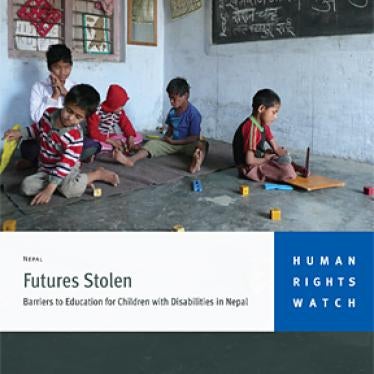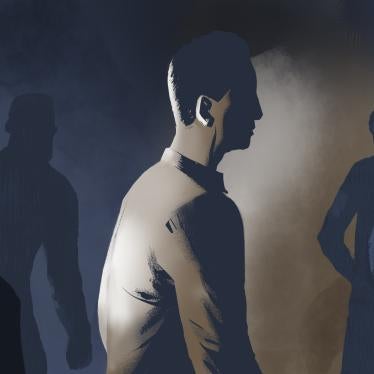Krishna, a 12-year old boy with a developmental disability, spends his entire day locked in a small room. His mother told me, “I can’t just look after him—my other child will miss his bus, everything will be in disarray.” She takes Krishna outside to see the sun once, or sometimes twice, a day.
Like thousands of other children with disabilities in Nepal, Krishna does not go to school. His mother took Krishna to public and private schools for children with disabilities, but each one turned him away. Because he does not sit still and cannot express when he needs to use the toilet, they said that they didn’t have the expertise or resources to deal with him.
For other children with disabilities in Nepal, there are other reasons: physical barriers, harassment. Children with disabilities or their parents may be discouraged in subtle ways. Some parents don’t know that their children have the same right to go to school as other children.
Yet for many families, having to educate and care for their children with disabilities without any help can be overwhelming. Schools not only provide education and basic life skills for children with disabilities—they offer a brief respite for parents. Krishna’s mother told me that if he went to school, it would help the whole family. Without this support, the result can be neglect and abuse. One mother of a child with autism frankly wondered: “If such children don’t know what to do, how to speak, can’t the state just give them a lethal injection to die?”
Considering the death of your child is hard to imagine, and speaks to parents’ desperation and fears about what will happen to their children after they are gone.
It does not have to be this way. Nepal, which has ratified treaties on the rights of children and of persons with disabilities, is obligated to protect and fulfill these rights. Simple, relatively inexpensive steps can advance children’s rights and offer parents support.
Improving educational opportunities helps children with disabilities become more independent and economically self-sufficient and can give them a sense of dignity. Integrating children with disabilities into schools also helps to address stereotypes and discrimination and can foster greater inclusion in the community.
Even seemingly simple efforts, like building a ramp to a school, can help improve the rights and dignity of children with disabilities. Amman, a 16-year old boy with a physical disability, uses a tricycle, pushed by his mother or other children in the community, to get to school. The school entrance has no access ramp. His mother brings him to the school’s gate, and he crawls up the steps to class every morning.
To help integrate children like Krishna, his local school can initiate a children’s club and peer-to-peer education programme, through which a fellow student can visit his home to help him learn basic skills.
Some efforts are already occurring to support children with disabilities in mainstream classrooms. In one school in southern Nepal, teachers adopted different teaching methods, including having students work in groups so students at different skill levels can assist and encourage one another.
Just outside of Kathmandu, one non-governmental organisation runs a day care centre for children with intellectual, developmental and multiple disabilities. This group has increased awareness among teachers, parents and students about the need to bring children with disabilities into mainstream schools through meetings and child-to-child interaction in class and on the playground. They have helped over 30 students with mild to moderate intellectual disabilities integrate into general schools.
In one school in Biratnagar, in eastern Nepal, deaf students are fully integrated with others and all teachers have learned sign language. The school provides support for the deaf children, including sign language training. But much more needs to be done to reach all children with disabilities nationwide.
First, the government, with support from development partners, should train teachers and parents of children with disabilities about how to include all children in the classroom. This means teaching teachers to teach differently. Modifying teaching techniques and the curriculum can challenge children who are more advanced and help children who need more support. This differentiated instruction approach not only benefits children with disabilities, but helps teachers generally to reach a broader range of students. Parents can also benefit from regular meetings to exchange information and provide peer support.
The government also needs a clear plan to integrate children with disabilities who are in school—but getting an inferior education in separate classrooms and schools—into mainstream schools. This plan should be developed together with disabled peoples’ organisations and parents. The government also needs to sensitise parents and the community about the right to education for young people like Krishna and Amman.
It will take time for Nepal to make the transition to a fully inclusive school system, and to make schools safe and accessible for all. But for families crumbling under the pressure of trying to secure an education for their children with disabilities and caring for them around the clock at home, it can’t happen soon enough.
Shantha Rau Barriga is a researcher and advocate for Human Rights Watch and author of a new report, “Futures Stolen: Barriers to Education for Children with Disabilities”








